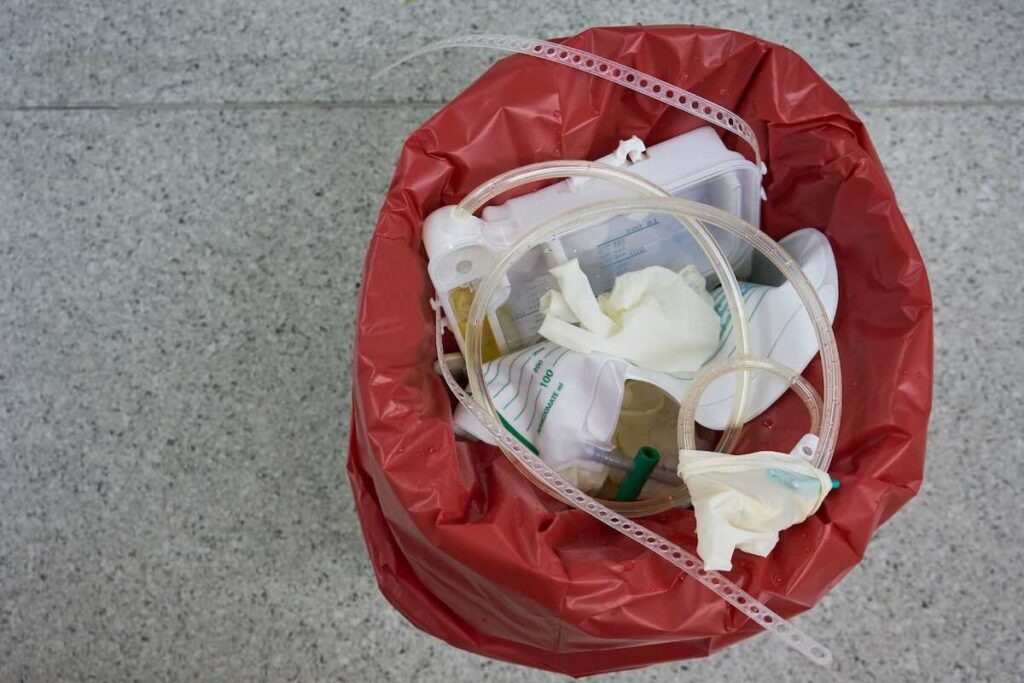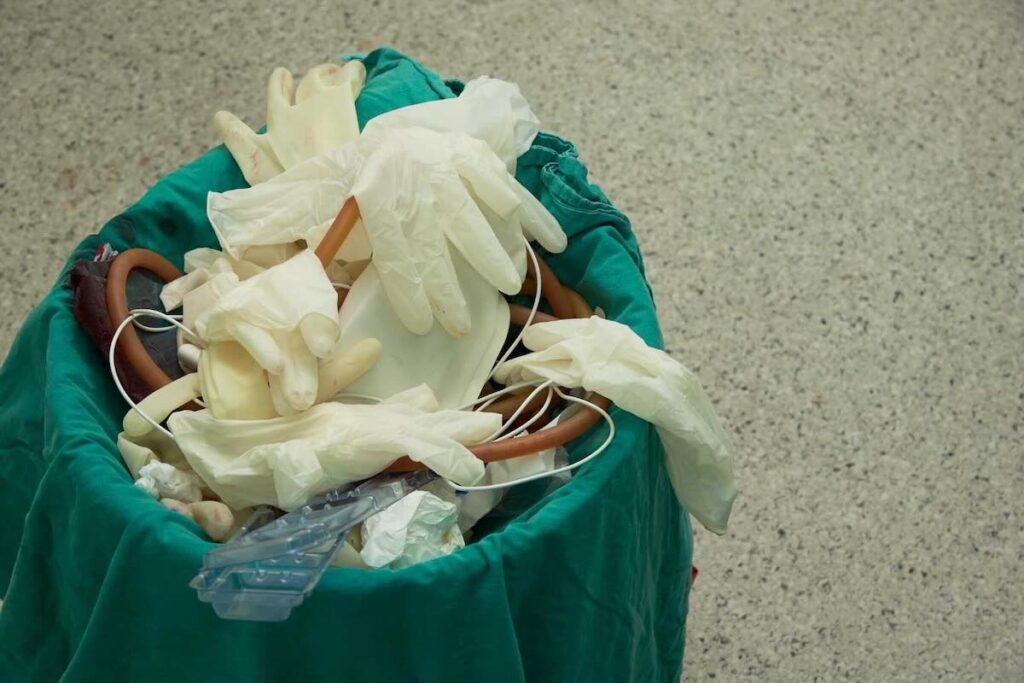Operating rooms are where surgery happens. They must be safe, secure, and highly sterile. Yet they’re also among the largest contributors to hospital waste. From disposable instruments and packaging to unused supplies, the sheer volume of waste generated during surgical procedures takes its toll on the environment. Healthcare professionals don’t usually have ecological objectives in mind, but this is a growing concern. Sustainability and eco-friendliness extend to all institutions.
This makes addressing these goals a business objective, but also a chance to improve efficiency, reduce costs, and lead the way in sustainable healthcare.
This article explores the problem of operating room waste, quantifies its impact, and offers practical solutions to help medical professionals and institutions take meaningful action.
Contents
The environmental impact of operating room waste
Operating rooms generate up to 30% of a hospital’s total waste and consume considerably more energy than every other hospital department. In a single day, operating rooms can contribute to 2,000 tons of medical waste. These large amounts of waste and energy expenditure have major environmental implications.
The production, sterilization, and disposal of surgical instruments and supplies put the environment at risk by producing carbon emissions. On the other hand, the disposal of surgical instruments and chemicals damages whole ecosystems by allowing the direct leaching of these substances into soil and water sources.
Plastic surgical supplies, which have become more popular in recent decades, are especially problematic. The inadequate disposal of surgical plastics can lead to ocean and landfill pollution, as these materials can take hundreds of years to decompose.
Surgical waste is often infectious or biohazardous. As such, it undergoes regulated medical waste (RMW) processing, which is extremely environmentally costly. In contrast, non-RMW processing involves handling and disposal procedures of supplies that do not pose a health hazard.
Quantifying OR waste
Operating room waste can be hazardous or non-hazardous. Hazardous waste includes potentially infectious waste, sharp instruments (such as needles), blood or blood derivates, anatomical waste, and pathological waste. In contrast, non-hazardous waste comprises body fluids, bandages, tissues, disposable supplies, catheters, and probes.
According to the World Health Organization (WHO), only 15% of hospital waste is hazardous. Despite this, 90% of non-hazardous waste in the operating room is classified as hazardous, resulting in exorbitant processing costs.

Most operating room waste is disposable surgical supplies, such as table covers, surgical drapes, face masks, and packaging. Generally, operating room waste is 39% textile, 26% plastic, 7% paper, and 27% a mixture of metal, glass, sharp products, anesthetic gases, medications, and other waste.
Carbon footprint of surgical procedures
The environmental impact of operating room waste goes beyond what we can see in the trash. Surgical procedures are important contributors to the emission of greenhouse gases, gases that impact climate change and global warming.
A study from Lancet Planet Health analyzing operating rooms in the US, UK, and Canada estimated an annual carbon footprint of 9.7 million tons of CO2e in these countries. According to the study, anesthetic gases and energy consumption were the primary sources of greenhouse gas emissions. The study also found that operating rooms were 3–6 times more energy-intense than the hospital as a whole because of their heating, ventilation, and air conditioning requirements.
Strategies for waste reduction in the operating room
To reduce operating room waste, hospitals must take sustainable approaches and follow good practices. A comprehensive review found that reducing OR waste along with its environmental impacts includes the following measures:
- Minimizing volatile anesthetics and general anesthesia
- Optimizing OR power consumption
- Optimizing the surgical approach and supply management
- Reusing, reprocessing, and recycling surgical instruments
- Improving waste management
- Promoting research, education, and leadership
Implementing efficient supply management
Efficient supply management is a prerequisite for optimal surgery. This measure aims to prevent redundancy by precisely balancing the demand for surgical devices required during surgery with the supply of the devices.
A study in HAND examined the number and impact of unused surgical supplies in hand surgery. It also aimed to propose ways to prevent unnecessary waste from unused supplies. A notable recommended practice from the study involved using so-called green packs for short procedures, such as carpal tunnel decompression surgeries. A green pack is a custom consolidated pack containing only the necessary instruments for the surgery at hand. For every hand surgery, using a green pack can decrease waste by 2.3 kg while saving $10.64.
Adopting reusable alternatives
Disposable surgical supplies are major contributors to greenhouse gas emissions. In contrast, reusable supplies can greatly reduce these gases. This is why current recommendations favor greater use of reusable alternatives when possible.
The reusable and recyclable versions of devices such as laparoscope components, laryngoscope blades and handles, anesthetic circuits, laryngeal masks, venous catheter kits, laparoscopic staplers, and ureteroscopes are more eco-friendly than their single-use counterparts. Similarly, surgical gowns, basins, sharps containers, drapes, caps, footwear, carpal tunnel blades, and trocars generate low waste when reused.
However some modern and partly disposable devices require only a small amount of waste to be disposed of or recycled, and may actually have a net benefit on the amount of waste.

For example, incorporating reusable devices like the Yasui koplight™ cordless lighted retractor can decrease reliance on disposable lighting equipment. The small and durable blades are disposed of, while the body/handle is reusable after cleaning and sterilization. A measure like this reduces medical waste while providing targeted surgical lighting for greater visibility. The koplight™ offers durable, sterilizable components and eliminates the need for single-use batteries.
Economic implications of OR waste reduction
Implementing “greener” operating room approaches not only protects the environment but also reduces hospital costs. Seemingly simple initiatives, such as switching from single-use to reusable surgical instruments or improving recycling, can being considerable financial savings in the long run.
Cost-benefit analysis of waste reduction initiatives
A review published in the Journal of the American College of Surgeons details the benefits that waste reduction initiatives can have in terms of hospital cost savings. The review found a single intervention involving a switch from a traditional to a waterless surgical scrub saved the hospital more than $2,000 and 2.7 million liters of water annually.
The review goes on to show that one of the most effective cost-saving initiatives was an education-related intervention. A US hospital saved almost $700,000 by training its staff on how to dispose of medical waste. This seemingly simple intervention reduced hospital medical waste by 30%.
The role of technology in OR waste reduction
Technological advancements can contribute to increasing sustainability in operating room practices. Artificial intelligence (AI) tools can potentially provide an alternative to manual evaluations of operating room waste levels. These tools can serve as systems that analyze large datasets of information and efficiently better track surgical supplies and waste.
Smart inventory systems
Automated inventory systems are computerized or AI tools that can monitor any given operating room device-related data: stock or supply, expiration date, level of use, and location across various hospital departments.
Through automation tools, hospitals can track surgical waste trends and develop strategies for reducing waste. Automation also reduces staff workload and lets staff members focus on the patient.
Researchers at the University of California San Francisco (UCSF) explored the application of automated AI technologies in recognizing and, then, successfully eliminating biohazardous (red bag) operating room waste. They concluded that implementing AI technology helped the hospital successfully eliminate biohazardous waste more than 90% of the time and save $4.22 per kilogram of waste. The technology also helped reduce landfill waste by 20% while also decreasing audit times from 20 minutes to just 1 minute.
Overcoming barriers to implementation
Adopting modern waste reduction practices is not as straightforward as it may seem. Any change in practice in a healthcare facility can encounter obstacles from staff members who may be used to certain routines of performing tasks. Maintaining proper leadership and staff training can help overcome such barriers.
Changing organizational culture
The organizational culture of a hospital involves the processes, values, goals and staff members that make up the hospital’s organizational structure. Carrying out organizational culture changes, such as changes aimed at improving waste management, directly impacts the hospital’s work environment.
A narrative review analyzing the integration of climate change into surgical planning in the WHO Western Pacific region suggested that educating healthcare providers on the environmental impact of their work reduces waste production. One way to implement this change is to label operating room supplies. Another is to include to provide training courses or lessons on sustainability to surgeons and operating room staff members. Measures like these are especially important for trainee surgeons, who tend to generate more waste than their senior colleagues.
Navigating regulatory and safety concerns
Various existing frameworks determine guidelines and safety measures regarding the management of operating room waste at an international, regional, or national level. Examples of such frameworks include the following:
- WHO healthcare waste management guidelines
- United Nations Basel Convention
- Occupational Safety and Health Administration (OSHA) guidelines
- EU Directive 2008/98/EC
- ISO 14001 – Environmental Management Systems
- The Australian National Waste Policy (NWP)
Hospitals are responsible for aligning their operating room practices with these guidelines and remaining updated on eventual changes.

